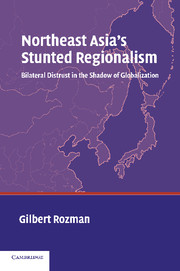Book contents
- Frontmatter
- Contents
- Acknowledgments
- Map
- Northeast Asia's Stunted Regionalism
- 1 Introduction: The Challenge of the Northeast Asia Region
- 2 Exiting the 1980s: Cold War Logic and National Aspirations
- 3 1991–1993: Border Fever and Cross-Border Duplicity
- 4 1994–1996: Civilizational Bridges and Historical Distrust
- 5 1997–1998: Strategic Partnerships and National Rivalries
- 6 1999–2000: Sunshine Policy and Security Dilemmas
- 7 2001–2003: Unilateralism and Irrepressible Regionalism
- 8 Conclusion: Lessons for Constructing Regionalism in Northeast Asia
- Index
7 - 2001–2003: Unilateralism and Irrepressible Regionalism
Published online by Cambridge University Press: 18 December 2009
- Frontmatter
- Contents
- Acknowledgments
- Map
- Northeast Asia's Stunted Regionalism
- 1 Introduction: The Challenge of the Northeast Asia Region
- 2 Exiting the 1980s: Cold War Logic and National Aspirations
- 3 1991–1993: Border Fever and Cross-Border Duplicity
- 4 1994–1996: Civilizational Bridges and Historical Distrust
- 5 1997–1998: Strategic Partnerships and National Rivalries
- 6 1999–2000: Sunshine Policy and Security Dilemmas
- 7 2001–2003: Unilateralism and Irrepressible Regionalism
- 8 Conclusion: Lessons for Constructing Regionalism in Northeast Asia
- Index
Summary
The balance shifted in 2001 to greater globalization, interpreted as priority for security and insistence on active U.S. leadership. The change began when the Bush administration took office and accelerated after the September 11 attack on the United States. This shift altered the environment for regionalism, which was squeezed between new U.S. assertiveness and resurgent nuclear blackmail by North Korea. By 2003 Japan's growing military activism and South Korea's reinforced soft posture toward the North aroused doubts that could have complicated the search for regionalism. If it seemed that divisive forces would overwhelm integrative ones, we can also find reminders that the main actors continued to pursue regionalism and now had additional reasons to work together.
Looking ahead to the year 2002, boosters of regionalism in early 2001 had seen the possibility of a breakthrough. Japan and South Korea would jointly hold the World Cup, drawing close together in this shared experience. Power in China would pass to a younger generation of better-educated leaders at the 16th Party Congress just as China would be implementing its WTO commitment to openness. Moving pragmatically closer to the West, Vladimir Putin would become a more reliable partner in Asia too as well as an energy supplier with a need for Asian markets. A new style of leadership in Japan by Koizumi Junichiro, who took office in April, would at last accelerate economic reforms and raise that country's leadership profile.
- Type
- Chapter
- Information
- Northeast Asia's Stunted RegionalismBilateral Distrust in the Shadow of Globalization, pp. 288 - 350Publisher: Cambridge University PressPrint publication year: 2004



